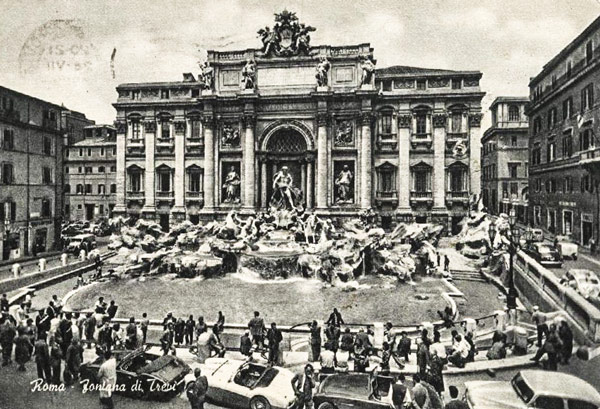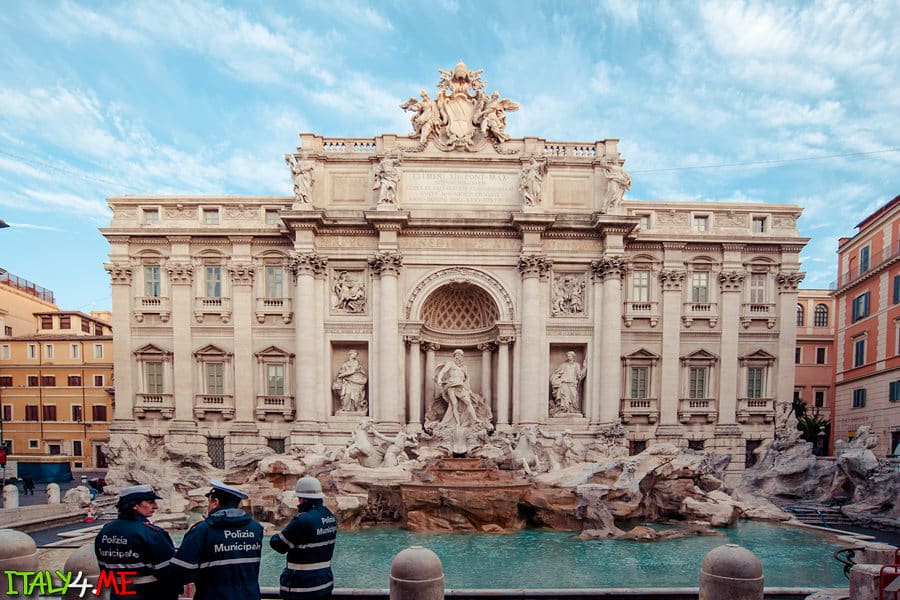The true gem among hundreds of attractions in Rome is considered to be the Trevi Fountain (Fontana di Trevi). The large-scale and spectacular landmark resembles a scene from an antique play made in stone rather than a source of pure water. The favorable location and incredible beauty of the fountain attract hundreds of visitors to the capital of Italy every day.
What do you need to know about the most famous fountain in Rome?
Page Contents
Summary to Save Time
History of Aqueduct Aqua Virgo
The Trevi Fountain was built in Rome in the 18th century. Emperor Octavian Augustus (lat.Octavianus Augustus) and his associate Mark Vipsanius Agrippa (lat.Marcus Vipsanius Agrippa) in the 20s BC. started a grand reorganization in Rome. Among the numerous reforms, Marcus Agrippa offered the Emperor to provide the capital with clean drinking water. As a result, Agrippa put a lot of effort into cleaning the city’s sewerage system and building a water supply system.
The newly built aqueduct received a romantic name – Aqua Virgo (lat. Aqua Virgo) – “Water of the Virgin.” Its waters covered a distance of 12 kilometers to fill the bowls of ancient Romans with crystal clear water.
Until the beginning of the 17th century, one could quench thirst from a modest spring flowing into a stone bowl in Trevi Square (Piazza di Trevi). Then, Pope Urban III decided to decorate the center of the capital with more impressive architecture. One of the greatest Baroque masters of Italy, Giovanni Lorenzo Bernini, was involved in the development of the new fountain project.
Read about ancient Roman aqueducts and baths.
Construction and Initial Design by Bernini
Bernini completed the initial design of the fountain, but the death of Urban III interrupted the project.
With the onset of 1700, Bernini’s student Carlo Fontana began to work on the project. Inheriting the baroque ideas of his teacher, Fontana framed them in a more restrained classical style. The architect enhanced the imagery of the original project by placing a powerful sculpture of Neptune and his servants at the head of the fountain.
Fontana died in 1714, and the construction of the building was stalled again. Finally, Pope Clement XII announced a competition for the position of chief architect. Nicola Salvi won in a struggle between sixteen eminent architectural engineers of the 18th century. The winner had a double task. On the one hand, he had to create something majestic and impressive. On the other hand, he had to organically fit his project into the architectural appearance of Trevi Square.
The Modern Look of Trevi Square
Looking at Trevi Square, a modern person will indeed perceive the Palazzo Poli and the fountain as a single architectural unit. Nicola Silvi did an excellent job. Well, in addition, under the guidance of the architect, sculptures of striking beauty were created.
The construction of the fountain took as long as 30 years: from 1732 to 1762. During this time, against the background of the baroque palazzo of the Italian nobleman, a scene from the life of the lord of the depths arose. The incarnate ocean, powerful and austere, breaks out from under the veil of water in a chariot drawn by sea horses and newts.
The architect incredibly vividly managed to convey movement in the stone, and the desire to reach the surface of the water. Involuntarily, holding your breath, you wait for the water cavalcade to continue its movement forward.
Trevi Fountain Statues
The statue of the God of the sea – personifies the water, which has brought its life-giving coolness to Rome for many centuries. Behind the left shoulder of Neptune, in the niche of the facade of Poli’s palace, is a statue of the Goddess of Health. To the right, she is accompanied by the Goddess of Abundance. Both ladies of stone greet with dignity and modesty crowds of visitors eager to take a look at the main fountain in Rome.
Visitors of the Italian capital flock to the sights for breathtaking views. In addition, tourists perform an obligatory ritual – they turn their backs to it and throw a coin over their shoulders. They say that by throwing a coin at the feet of the goddesses, one can count on their favor.
More often than not, travelers who are puffed up by the beauty of the fountain throw a few coins at the bottom of it: for luck, in the hope of meeting their soulmate and, of course, to visit Italy and Rome again!
What does the name of the Trevi Fountain mean?
There are several versions of its origin. The most widespread is the three principal streets of Rome converge at Trevi Square. Latin experts argue that the Italian “trevi” actually came from a distortion of the Latin “trivium,” which means “three-way.” The second legend says that a young maiden named Trivia was able to tell the builders of the ancient aqueduct the place where the key to drinking water lies.
Quite often tourists hesitate about how to put stress correctly: TrEvi or maybe TrevI? The native inhabitants of Italy know for sure that it is TrEvi – the emphasis on the first syllable.
Interesting facts about the Trevi Fountain
Fountain di Trevi is the record holder among its fellows throughout Italy. Its width reaches 20 meters, and the height in the center is 26 meters!
In addition to its impressive size, the artificial reservoir can be proud of the neighborhood with an old mansion. In due time, Princess Zinaida Alexandrovna Volkonskaya rented the second floor of the Palazzo Poli in the 1830s.
As one of the most popular destinations in Rome, the Trevi Fountain can often be seen on postcards, photographs, and videos. However, the fountain played its most notable role in the film La Dolce Vita, directed by Federico Fellini.
The symbol of Italian cinematography Marcello Mastroianni and blonde Anita Ekberg played out a hot scene in the icy water of January di Trevi.
Director William Wyler also used the fountain and other Roman attractions to shoot Audrey Hepburn and Gregory Peck. The rebellious macho Adriano Celentano showed Rome in all its glory to the overseas princess Ornella Muti in the movie Madly in Love (Innamorato pazzo).
Restoration
In June 2014, the fountain was officially closed for about a year on reconstruction. The reason for this was the general decay of stone structures, daily undermined by water and the influx of tourists. The previous restoration of the attraction took place 125 years ago! The wake-up call came in 2012 when the magnificent sculptures began to lose their parts and needed urgent repairs.
By the way, everyday tourists threw about 1.500 EUR into the blue waters of di Trevi! This is a good income, bringing in more than a million euros annually.
However, the restoration of the famous fountain has attracted the interest of the Fendi fashion house. According to preliminary estimates, the amount required for the restoration of the art monument at that time was 2 million 200 thousand euros.
Italians decided not to deprive tourists of the opportunity to admire the grandiose Roman curiosity. Even though the restoration was in full swing. Local authorities draped the monument with transparent screens made of durable material. Everyone could walk through special scaffolding built over the spring bowl. Of course, it was impossible to enjoy this part of Rome fully. However, all inconveniences were a matter of time.
Nowadays, the fountain has come back to work! So we invite you to admire the main sights of Rome at dawn in the company of the guides of the ITALY FOR ME team, who are in love with the Eternal City.
Location – How to get to Trevi Fountain
Address: Piazza di Trevi, 00187 Roma
You can get there by metro, line A, metro station – Spagna or Barberini. Then, a short walk will lead you straight to the square and the fountain.
 Italy for me From Italy with love
Italy for me From Italy with love






